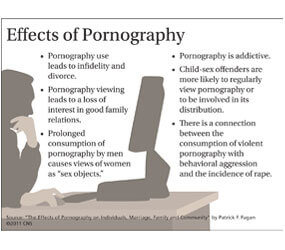WASHINGTON – Pornography is being blamed for the deterioration of values in American society. A recently launched campaign, War on Illegal Pornography, contends as much, citing divorce, violence against women, increased sex trafficking and porn addiction as just some of the unhealthy results.
But someone declaring porn to be illegal does not work in and of itself. Prosecution of pornography purveyors is required for porn to be found illegal. But even that definition is hard to corral, since no new charges on pornography trafficking have been brought by the federal Justice Department in more than two years, according to Patrick Trueman, president of Morality in Media.
One need not be exposed to porn to be degraded by it. Families where only one person watches pornography can be adversely affected, said Mary Anne Layden, a psychotherapist and researcher on the staff of the medical school at the University of Pennsylvania.
Trueman, who was the chief enforcement officer for the Justice Department’s child exploitation and obscenity section in the last year of Ronald Reagan’s presidency and for all four years of the George H.W. Bush administration, said that, before he became Morality in Media’s president, he was asked by its board chairman two years ago why pornography had become less of a priority.
“It’s easy to see why,” Trueman said he replied. “The Justice Department has moved this way down” on its priority list.
Thus began the War on Illegal Pornography, a coalition of 110 organizations that want existing laws to be enforced. Among coalition members is the Catholic Family Institute, which monitors United Nations issues.
“The reason we started the War on Illegal Pornography was to get the Justice Department to prosecute cases. But we never expected the Obama administration to be our champion,” Trueman told Catholic News Service. “The administration might take on a couple of cases, but the next administration – he or she, if it is a Republican – might be persuaded to take cases.”
Trueman said he sees the rate of porn addiction rising, not only among men but children as well, because their curiosity is not met with blocking software.
“Marriages are breaking up because of one spouse or the other being addicted to pornography. You’ve got violence against women increasing, he said. “Men are watching porn movies that are very violent and they want their wife or partner to repeat out what they see in the films. There’s an increase in sexual trafficking, because as men see pornography they’re hiring prostitutes.
“Of course, many prostitutes are sexually trafficked. There are websites that feature women who will do what the consumer wants. You put in a credit card (number) and the consumer gets that film and the porn industry can sell that film as well.”
Trueman said pornography has contributed to a coarsening of society.
“Men who are involved with porn, as consumers, discard their spiritual life. They have no spiritual life. They have no family life. Their wife doesn’t look good to them, after watching Internet pornography where the models are always young and in perfect shape with their airbrushed bodies,” Trueman said, “so marriages break down and fall apart.”
Layden told CNS that the harmful effects of pornography are widespread. “It depends on what negative influence you want to look at,” she said.
Among them are sex addiction, pornography addiction, connections to criminal behavior, rape, incest, sex trafficking, domestic violence, relationship damage, marital infidelity, callous attitudes, and the impact on children either through exposure to porn or sexualized media and the ill effects of their early sexual activity.
“We’re talking about consumers at this point,” Layden said. “We haven’t even talked about the (sexual) partners, the performers, the individuals who are performing in pornographic activities, whether it’s video, strip clubs, the sexual exploitation industry, where sexual exploitation is what we’re selling.
“And I haven’t even named all the damage. I’m just touching the surface here.”
Layden pointed out an ironic conundrum: “The increasing amount of research that indicates that pornographic imagery is damaging makes it harder to do any research on it. For those of us who are in academic institutions, our research has to be cleared by an institutional review board,” she said. “You’re mandated not to hurt your subjects. … What institutional review board is going to give you permission to do your study?”
She pointed to a 1984 study by Dolf Zillmann and Jennings Bryant in which three groups of subjects watched four hours and 48 minutes of video. One group saw no pornography, one group spent half of the time watching porn, and the third group watched all porn. Afterward, members of each group were asked a series of questions on issues of the day.
“They were asked questions like: How much time should a rapist spend in jail? What do you think of the women’s liberation movement? How many people do you think are having sex with animals? Group sex? Violent sex? Middle group was still in the middle. People who had seen the pornography reduced their support of the women’s movement by 50 percent,” Layden said. In response to another question, she added, “Rapists would spend about 50 percent less time in jail; that was true of the (porn-watching) females as well.”
Layden said she is doing a longitudinal study of the consequences of pornography over time, noting that researchers are limited to certain kinds of studies and research has to be cleared by an institutional review board to make sure a researcher doesn’t harm his or her subjects.
She added she would never make her subjects watch porn knowing what she knows now, because “it would be unethical,” noting that it is inevitable that some therapist or researcher will be sued or investigated for encouraging patients, clients or subjects to watch pornography.


